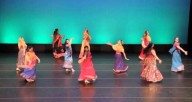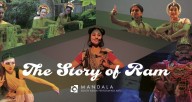Mandala South Asian Performing Arts paints with broad strokes, adopting a multi-cultural, multi-genre lens. Rather than narrowly focusing on preservation of a single classical dance form, they say “yes” to pretty much everything. It’s a difference of approach that associate artistic director Ashwaty Chennat says reflects the experience of South Asians living in America.
Mandala's work is not just broad; it's also deep. Chennat’s training in classical bharatanatyam (and also that of founder and director Pranita Nayar), infuses much of their work. And collaborators with expertise in other forms bring their wealth of experiences to the table, too. They are fluent in everything from salon-style classical dance concerts to experimental film screenings.
“We can’t really imagine doing anything that’s specifically one culture because what we do is interwoven with our experiences being in the United States and the diaspora,” Chennat said in a phone call. “We see the value of solidarity with other communities.”
Works like “The Story of Ram,” on view at Naper Settlement this Saturday, are a prime example, offering the dance version of tapas and featuring many cultures, with the lines between forms meeting but not necessarily blurring.
In that way, “The Story of Ram” resembles the 2018 “Masks & Myths,” another iteration of this "It's a Small World" format taking patrons around the globe. “The Story of Ram” is distinct from “Masks & Myths” in that it specifically leans on the Ramayana for inspiration.
Now in its sixth season, the ever-evolving “Story of Ram” will also be decidedly different than any previous year, moving from Hyde Park’s Logan Center to a suburban, outdoor setting at Naper Settlement. The production was originally designed as an educational performance for kids in celebration of Diwali, a major interfaith holiday celebrated by Hindus, Sikhs and Jains.
“Diwali is a celebration of light over darkness or good triumphing over evil,” Chennat said, adding that the Hindu epic that inspired “The Story of Ram” is often told during the holiday. “What we’re doing is weaving in many tellings of the Ramayana as told by different perspectives and cultures,” said Chennat.
The inspiration to create a multicultural manifestation of the Ramayana came from Nayar’s two decades long creative partnership with Balinese dance and music master I Gusti Pak Ngurah Kertayuda.
“They started telling the Ramayana together, just the two of them,” Chennat said. “This production came out of an opportunity to create a children’s show. We decided to invite more youth artists and fill it out with a ‘Nutcracker’ kind of vibe, where we’re telling a story that is important to different cultures this time of the year.”
But of course, “The Nutcracker” does not typically concern itself with authenticity, whereas “The Story of Ram” recruits practitioners with expertise in Indian, Brazilian, Indonesian and Thai dance and music.
While going outside was a pandemic pivot born out of necessity, the decision to bring “The Story of Ram” specifically to Naper Settlement was intentional. “The Story of Ram” takes place in the front yards of stately, colonial-style, historic homes, a symbolic but also literal nod to two diasporas that acknowledges the large South Asian immigrant community in the Western suburbs.
As the audience moves throughout the park, they stop periodically to observe vignettes, each telling the next part of the story interpreted through a different cultural lens. Chennat accompanies the group the whole time, narrating the tale and portraying the monkey king Hanuman.
In a nutshell, the solider prince Ram, his wife Sita and his brother Lakshman are banished to the forest for 14 years. A dispute between Ram and Ravana, a kingly intellectual whose eyes are set on Sita, sets forward a cascade of events, including Sita’s brutal kidnapping. To rescue Sita, Ram and Lakshman recruit an animal army to help.
And they live happily ever after?
“Oh boy, no, but that’s where our story stops!” Chennat said. By telling the story linearly, but from multiple perspectives spanning both cultures and times, the audience gets a glimpse not only of the universal themes present in the Ramayana, but also the nuances of how ancient texts are interpreted in contemporary life.
“The Ramayana changes in tone, depending on who’s telling it," Chennat said. "Sometimes it’s purely comical. There are very austere tellings and others that are joyful. With each telling, it changes. We’re trying to show the power of that.”
--
Mandala South Asian Performing Arts presents “The Story of Ram,” an outdoor immersive performance, Oct. 9 at 11 a.m., 2 p.m. and 5 p.m. at the Naper Settlement, 523 South Webster Street, Naperville. Tickets are $25 general admission at 11 a.m. and 2 p.m.; tickets for the 5 p.m. fundraiser performance are $100. Tickets and information are available by clicking the event page below.



